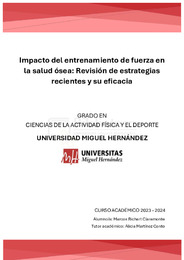Por favor, use este identificador para citar o enlazar este ítem:
https://hdl.handle.net/11000/32851Impacto del entrenamiento de fuerza en la salud ósea: Revisión de estrategias recientes y su eficacia
| Título : Impacto del entrenamiento de fuerza en la salud ósea: Revisión de estrategias recientes y su eficacia |
| Autor : Richart Claramonte, Marcos |
| Tutor: Martínez Canto, Alicia |
| Editor : Universidad Miguel Hernández de Elche |
| Departamento: Departamentos de la UMH::Ciencias del Deporte |
| Fecha de publicación: 2024-06 |
| URI : https://hdl.handle.net/11000/32851 |
| Resumen : Objetivo: Analizar la literatura más reciente sobre los programas de entrenamiento de fuerza dirigidos a mujeres postmenopáusicas con baja densidad mineral ósea, con especial atención en la comparación de distintos enfoques de entrenamiento. El objetivo es confirmar si el entrenamiento de fuerza de alta intensidad es el único entrenamiento capaz mejorar la salud ósea en esta población dentro de otros posibles programas de entrenamiento de fuerza con distintas estrategias y/o intensidades. Asimismo, se busca identificar las estrategias de entrenamiento de fuerza más actuales que hayan tenido resultados positivos, con la finalidad de desarrollar un programa de entrenamiento de fuerza completo que integre las directrices de las estrategias estudiadas en esta revisión para mejorar la salud ósea en mujeres postmenopáusicas con baja densidad mineral ósea. Método: Revisión sistemática de artículos de ensayos clínicos o ensayos controlados aleatorizados siguiendo la guía PRISMA, realizando una búsqueda de la literatura en tres bases de datos (PubMed, Scopus y SportDiscuss) a través de la utilización de palabras clave con marcadores boleanos y, desde 2013 hasta la actualidad. Criterios de inclusión, mujeres postmenopáusicas con baja densidad mineral ósea (T-Score < -1.0). Resultados: Para la revisión se incluyeron 7 estudios, 1 estudio fue descartado después de analizarlo tras ofrecer un riesgo de sesgo elevado. Los programas de entrenamiento de fuerza a alta intensidad (70-85% del 1RM) fueron los más efectivos para la mejora de la salud ósea en mujeres postmenopáusicas con baja densidad mineral ósea. Un programa de moderada intensidad alternando intensidades dentro de la misma serie (70% y 50% del 1RM) mostró mejoras significativas a pesar de ser moderada intensidad. Otro programa de entrenamiento de fuerza máxima fue efectivo en un tiempo corto de intervención y fue seguro por aplicarlo bajo supervisión profesional. Un programa de entrenamiento de fuerza de baja intensidad aplicando restricción del flujo sanguíneo mostró mejoras significativas en los biomarcadores de remodelación ósea. Conclusión: Se concluye que el entrenamiento de fuerza de alta intensidad es la mejor estrategia para mejorar la salud ósea en mujeres postmenopáusicas con baja densidad mineral ósea. No obstante, programas de intensidad moderada con una estrategia concreta o programas de baja intensidad con restricción del flujo sanguíneo pueden ser estrategias también efectivas principalmente para mujeres postmenopáusicas con densidad mineral ósea muy baja. Objective: Analyze the most recent literature on strength training programs aimed at postmenopausal women with low bone mineral density, with particular emphasis on comparing different training approaches. The objective is to determine whether high-intensity strength training is the only type of training capable of improving bone health in this population, as compared to other possible strength training programs with various strategies and/or intensities. Additionally, this review seeks to identify the most current strength training strategies that have yielded positive results, with the aim of developing a comprehensive strength training program that incorporates the guidelines from the strategies studied in this review to improve bone health in postmenopausal women with low bone mineral density. Method: Systematic review of clinical trials or randomized controlled trials following the PRISMA guidelines, conducting a literature search in three databases (PubMed, Scopus, and SportDiscuss) using keywords with Boolean operators, from 2013 to the present. Inclusion criteria was postmenopausal women with low bone mineral density (T-Score < -1.0). Results: The review included 7 studies. One of them has been rejected after analysis due to a high risk of bias. High-intensity strength training programs (70-85% of 1RM) were the most effective for improving bone health in postmenopausal women with low bone mineral density. A program of moderate intensity alternating intensities within the same set (70% and 50% of 1RM) showed significant improvements despite being of moderate intensity. Another maximum strength training program was effective in a short intervention time and was safe when applied under professional supervision. A low-intensity strength training program applying blood flow restriction showed significant improvements in bone remodelling biomarkers. Conclusion: It is concluded that high-intensity strength training is the best strategy for improving bone health in postmenopausal women with low bone mineral density. However, moderate-intensity programs with a specific strategy or low-intensity programs with blood flow restriction may also be effective strategies, primarily for postmenopausal women with very low bone mineral density. |
| Palabras clave/Materias: osteoporosis baja densidad mineral ósea entrenamiento de fuerza low bone mineral density strength training |
| Área de conocimiento : CDU: Bellas artes: Diversiones. Espectáculos. Cine. Teatro. Danza. Juegos.Deportes |
| Tipo de documento : info:eu-repo/semantics/bachelorThesis |
| Derechos de acceso: info:eu-repo/semantics/openAccess |
| Aparece en las colecciones: TFG - CC. de la Actividad Física y el Deporte |
 La licencia se describe como: Atribución-NonComercial-NoDerivada 4.0 Internacional.
La licencia se describe como: Atribución-NonComercial-NoDerivada 4.0 Internacional.
.png)
